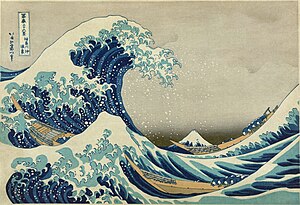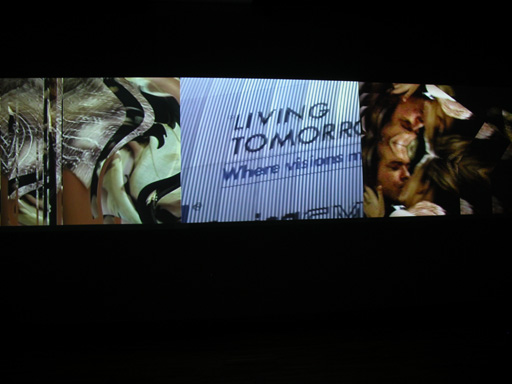Greetings from Law Lecture Theatre 101 at The University of Sydney where
Richard Francis-Jones, Design Director of Francis-Jones Morehen Thorp (fjmt) is about to deliver the 2009 Wilkinson Lecture. The topic is "
Identity Crisis: Dilution of public domain & the rise of the art museum as urban panacea of our time". This seems to be about museums becoming more commercial, but that should become clear as we go along. There will be a podcast available after the talk and I will provide a link to it.
The Wilkinson Lecture is named in honour of
Professor Leslie Wilkinson the architect who was responsible for many of the early campus buildings.
Richard Francis-Jones is architect of the
new law building at University of Sydney, were the talk is being held.
Mr.
Francis-Jones started with a grim monochrome view of the Sydney skyline. He argued that we should not see the commercialisation of the modern city as entirely negative. He then argued that virtual public spaces, such as Iranian Internet protests, were positive. He related this to the boulevards of Paris, which were part design to control protest.
Shopping centres and airports are, argues Mr. Francis-Jones, pseudo public spaces, having the appearance of public but being design for turbo-consumerism. He argues that architects have become enamoured of designing such spaces, which like Dubai, which has no social answer to spiritual needs and becomes a city of consumer junkies in a consumer monoculture.
Mr. Francis-Jones sees the public library and art museum as a bulwarks against the advance of the shopping centre. He used the example of the
Blacktown Public Library. He argues that the art museum is the temple of the 21st century city, but while becoming a public brand for the city with a landmark building by a well known architect.
The example used was the "Bilbao Effect" named for the
Guggenheim Museum Bilbao by architect Frank
Gehry. This one building is credited with boosting the economy of the city and region around it. The
Sydney Opera House is a global brand now for Sydney.
Mr. Francis-Jones then attempted to draw a distinction between the artistic integrity of the Sydney Opera House and Bilbao as architecture as sculpture. Is the art building just a "decorated shed"? I think he is on very shaky ground here: the Sydney opera house is not a very functional building and far from just a shed to put art in. Also he seems to forget that a museum building is not a museum, it is a building for some of the artefact's and functions.
The discussion became even more shaky by comparison of buildings with
Uluru (Ayers Rock). Uluru is a sacred and supernaturally constructed object to the
Pitjantjatjara and
Yankunytjatjara people. To compare this with architecture might be too much like seeing architects as gods.
Mr. Francis-Jones then got onto firmer ground by showing his designs for the
extensions to the Auckland Art Gallery (Toi o Tamaki). This will have a floating canopy of
kauri. The design has received positive, if
sometimes grudging, comments.
One questioner asked if the law library in this new building should be so noisy. The architect argued the library should have different spaces with different acoustic qualities. There are "live " spaces designed for silence and other softer spaces for conversation.
I asked if the western idea of an art museum was too pure. In 2005 I spent a week in
Samoa teaching web design to museum staff from across the pacific for a UNESCO project. One aspect of this was that many of the museums represented were commercial and craft workshops. They did not just display old objects and high art, there were contemporary items on display. These museums also held cultural events, with dance and music as well as provided facilities for works to be produced and sold. Mr. Francis-Jones pointed out this was a complex issue and that he illustrated his talks with many art works which were in public spaces, not isolated in galleries.
The host ended the evening by pointing out it was brave for an architect to give a talk in his own building. This was a useful reminder that whatever architects might say, it is by the buildings they build they must be judged. The extensions to the Auckland Art Gallery look interesting, but I am not so sure about the new University of Sydney Law building. Perhaps this is what the client wanted, but it is a huge imposing structure, not on a human scale. From the outside it is not clear how to get into the building, or if there are actually any people in there. Inside the corridors outside the lecture theatres reminded me of a modern railway station, with vast expanses of very wide corridors. I feel very small and isolated, wandering along looking for a toilet.
Lecture theatre 101 was well designed and equipped. I found the pull out table on each seat was just the right size for my netbook, but there were no power points (I had to plug my 3G wireless station into the podium at the front of the room, which the average student could not do). However, it is not clear to me what exactly is supposed to happen in these big rooms: surely the University is not expecting to provide education here?
The University of Sydney Law building reminds me of a 19th century factory building where rows of workers used to labour. New methods of production have been developed which have rendered these buildings obsolete. In the same way new methods of university education have arrived which have rendered large lecture theatres full of rows of students obsolete. It is handy to have a large room for the occasional public oration, but in educational terms this is an obsolete facility.
The university would have been better off with a more human scale (and cheaper) multi purpose building with a
flexible learning centre. Rooms with flat floors are adaptable to multiple uses and refurbishment. It is going to be very difficult and expensive to refit the University of Sydney Law building to be used for modern education. It would be a shame to have to demolish a new building, but that might be the most economic option.
Labels: Architecture, Art, museums, samoa, Sydney, Univeristy of Sydney









